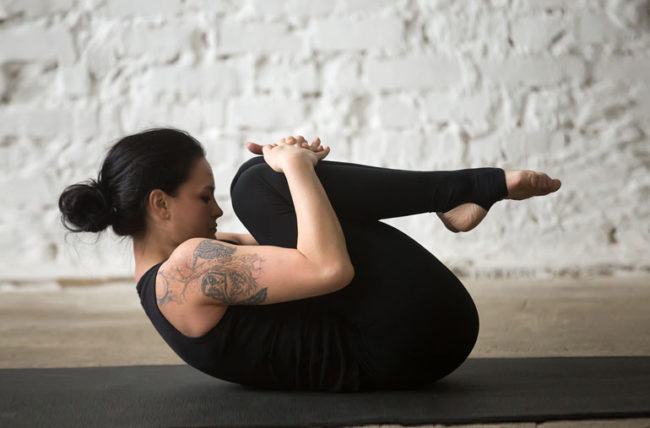
While practicing yoga, knee pain is a common problem for many people. Although it may sound counter-intuitive, it can be the perfect therapy for your particular condition. Outside Learn has in-depth courses about yoga and nutrition for knee pain. Click on these links to find out which class is best for you. You can choose a class that is convenient for your schedule and levels of pain.
The butterfly position is one of most popular yoga knee pain exercises. The butterfly pose, which is a seated position, requires that the soles of your feet are together and the knees are bent wide. This exercise benefits the hip flexors as well as your groin. To reduce strain on your knees, perform the exercise with either slightly bent or straight legs. You can switch sides if you experience discomfort to keep your knees from straining.

Your knee micro-bend is key to making yoga safe for your knees. This posture reduces hyperextension. It also ignites the surrounding muscles, increasing strength and flexibility. The best pose for knee pain is the lunge. However, be gentle with yourself and modify as necessary. Remember, yoga isn't a quick fix, but it can help reduce the pain you are feeling and keep your joints in good health.
If you have knee pain, the best yoga pose for it is the kneeling pose. You can do it on towels, blankets, or blocks. Holding this position, you should pull your calf muscles up and place your hips under your ankles. You can pull your buttock flesh up and raise your knees. You should hold the pose for at least five to eight minutes. You can hold the position for longer if you are able.
A knee-healing stretch is one of most effective ways to stretch your knees. It puts a lot of pressure on the knees and can cause ligament strain. If you have sensitive knees or joint pain, it is best to avoid this position and consult a doctor if needed. To get a correct diagnosis and treatment for any injuries you may have suffered in the past, please consult your doctor. To strengthen your body and alleviate pain in your knees, you should learn yoga.

Certain types of yoga can cause pain in the knees. Although you should avoid yoga poses that put pressure on the knees, you can modify some of these poses to lessen the impact on your knees. A yoga block can be used to relieve pressure and pain from your knee. These blocks will help you to balance well while in the pose. A knee injury can make it difficult to perform certain asanas. You should immediately contact your doctor to avoid any discomfort during yoga.
FAQ
How many calories per day should I consume?
It varies from one person to another. On average, you need 2000 to 2500 calories per days. Based on your age, gender, height and activity level, you will need to calculate how many calories you require.
Do I have the obligation to exercise every day or just on occasion?
No! At least 30 minutes moderate-intensity exercise five days per week is a good goal. It means you need to exercise hard enough or walk fast enough that you are slightly out-of- breath.
Can I consume alcohol while working out?
Yes. Alcohol can increase energy expenditure, speed up healing time, and reduce soreness.
Alcohol also increases insulin sensitivity, making it easier to absorb glucose.
Dehydration can result from alcohol, which can affect your metabolism. You may also experience a reduction in testosterone production which can lead to decreased muscle-building potential.
This is why women shouldn't have alcoholic drinks before exercising. Women who drink heavily should wait at the least 24 hours before exercising.
Breastfeeding women should stay away from alcohol.
Men should only consume one drink per day.
What dietary supplement is best for weight loss?
Losing weight requires both diet and exercise. Some people find that certain supplementation can be helpful.
Some studies suggest that omega-3 fatty acids may help with weight loss. Omega-3 fatty acid is an essential fat that is important for brain function as well as cell membrane integrity. They are found in fish like salmon, tuna, shrimp and cod liver oil.
Another study suggests that green-tea might help with weight loss. Green tea is rich in catechins, antioxidants which may boost metabolism and aid weight loss.
Statistics
- By John Thompson Take a whopping 38% off a set of PowerBlock Pros. (menshealth.com)
- 10 pounds in a month is likely during a lean bulking phase, especially for beginners. (muscleandstrength.com)
- Cardmembers earn 5% Back at Amazon.com with a Prime Credit Card. (amazon.com)
- Get free shipping and 25% off today. (healthline.com)
- According to the American Heart Association, blood pressure should be checked at least once every two years, beginning at age 20. (my.clevelandclinic.org)
External Links
How To
How can I burn fat and exercise?
Exercise burns calories through increased metabolism and oxygen consumption.
Moderate intensity exercise is a safe way to lose weight.
These are the top tips for burning fat while you exercise.
-
Do cardio exercises such as walking, swimming, jogging, cycling, running, or elliptical training.
-
You can exercise for 30 mins three times per week.
-
You can lose weight by adding strength training to the routine.
-
Avoid intense training. You can build muscle without having to lose muscle tissue.
-
Keep hydrated during exercise. Water flushes out toxins, and keeps your body properly hydrated.
-
After working out, make sure to drink low-fat proteins shakes. Protein shakes are great for your muscles and energy.
-
Eat smaller meals throughout the day, so you don't feel hungry between meals.
-
Don't skip breakfast! You can feel tired and slow if you skip breakfast.
-
Take care of your mental health. Stressful situations can slow down metabolism.
-
Keep a positive attitude. Studies show that overweight people are more likely to be obese than those who perceive themselves as attractive.
-
Get enough sleep. Lack of sleep makes it harder to burn fat.
-
Keep active. Make sure you get up and move every hour.
-
Maintain a healthy diet. Healthy eating will keep you fuller and more satisfied for longer.
-
Relaxation is possible by finding ways to relax. Relaxing doesn't mean your body releases stress hormones which cause muscle tissue to be destroyed.
A balanced diet is one that includes all of the essential nutrients required for growth.
Six small meals per day is better than three large meals. This gives your body the time it needs to process what you've eat.
Calcium is required to support strong bones. Calcium is available in dairy products like milk, yogurt, fortified soy beverages, orange juice, cereal, bread, and cereals.
Calcium comes from leafy green vegetables, beans, tofu, nuts, seeds, and cheese.
Vitamin D is essential for calcium absorption. It's found in fatty fish, egg yolk, and some fortified foods.
Vitamin E is important for skin health. Vitamin E can also be found in vegetable oil, wheat germ oils, peanuts as well almonds, sunflower seeds and corn.
Your body requires zinc for normal immune function and wound healing. Zinc can be found as a mineral in oysters.
Zinc deficiency can cause fatigue and loss of appetite. It can also lead to depression and impaired immunity.
Consuming too much sugar can cause insulin resistance. This causes an increase in blood glucose levels. Insulin resistance leads to weight gain.
Insulin resistance occurs when the bloodstream is full of free radicals. Free radicals refer to molecules that contain unpaired electrons. They can damage cell membranes and other body parts.
The most common sources of free radicals include food additives.
Free radical damage can lead cancer, heart disease or diabetes, arthritis, asthma, or other forms of aging.
The best way to avoid free radicals is to eat a balanced diet high in antioxidants. Antioxidants protect against oxidative damage.
Antioxidant vitamins include Vitamin C (found in citrus fruits), beta carotene (found in carrots, sweet potatoes, spinach, broccoli, cantaloupe, apricots, squash, mangoes, peaches, peppers, tomatoes, cabbage, cauliflower, kale, Brussels sprouts, collard greens, watermelon, and strawberries), and Vitamin E (found in nuts, olive oil, avocados, and eggs).
Selenium, manganese (and zinc) are other antioxidant nutrients.
Selenium is known to protect cells from the oxidative damage that free radicals can cause. Selenium is found in Brazil nuts, tuna, liver, kidney, shrimp, cod, turkey, beef, lamb, pork, and chicken.
Copper protects eyes, brain, lungs and red cells. Copper can be found in meat, shellfish, meat, and organ meats.
Manganese is essential for bone structure. Manganese is found in brown rice, spinach, bananas, prunes, raisins, oatmeal, and lentils.
Zinc is important for healthy growth, reproduction, and wound-healing. Zn is found in lean cuts of meat, white fish, poultry, and eggs.